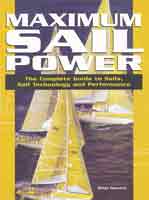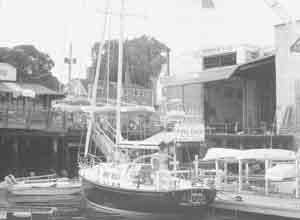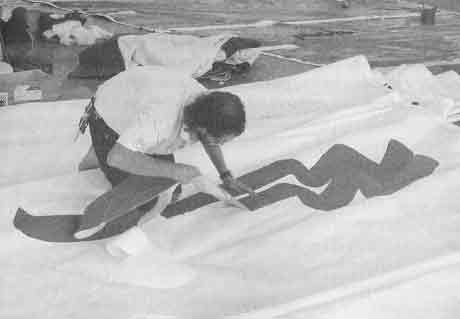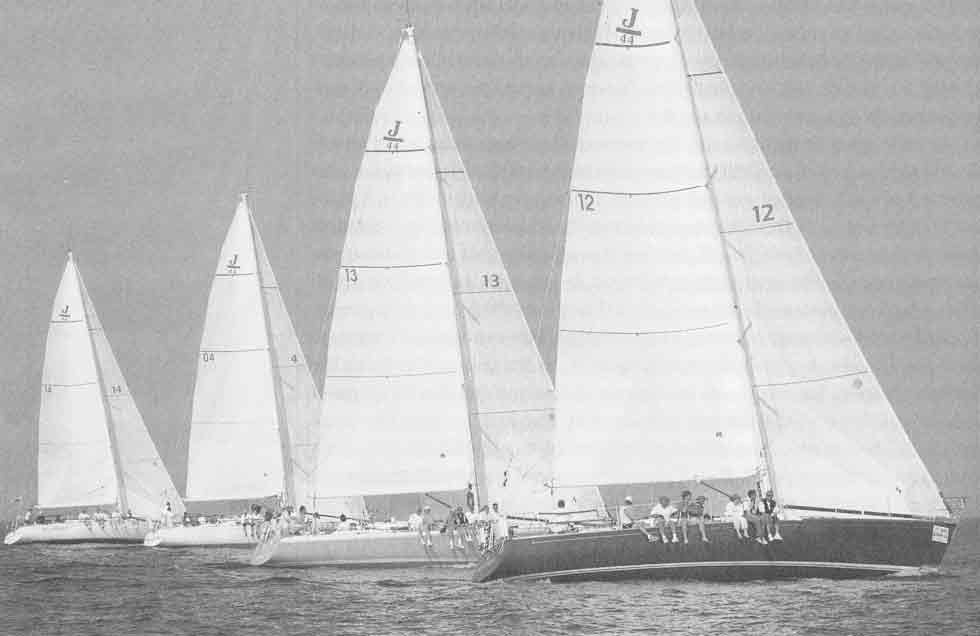It was not so many years ago that buying a new sail for your boat meant a pleasant trip down to your local sailmaker. You made a call (e-mail was not yet invented), set up an appointment, and then spent a few wonderful hours looking at bolts of cloth, talking boats and settling on a price. If you were a good customer a handshake would seal the deal, the sail would be made and a few weeks after it was delivered to your boat an invoice would arrive by mail. Your sailmaker knew you by name-both yours and your boat's-just as your family doctor knew your medical history. More often than not the sailmaker would bend the sail on personally, take the boat out for a sail to check the fit and cut of your new purchase, and generally treat you like, well, a customer. Those days, however, are long gone. We live in a much more technically advanced world where even important purchases like a new sail are done via e-mail, phone, the Web or some other "convenient" means. Old-fashioned service is gone, unless of course you are spending upwards of fifty thousand dollars, and that's not necessarily a bad thing, since then, as now, that service didn't come cheap. True, you want the sail to fit right, look good and perform well, but you also want all these things at a reasonable price. For a sailmaker, spending the afternoon out sailing with a customer, while a pleasant experience for both parties, is costly, and that cost inevitably has to be added on to the price of the sail. These days, with modern fabrics, computer technology and vast databanks of empirical information, the chances of a sail not fitting perfectly and looking good the first time out are becoming increasingly remote. In fact, the truth is that today you really don't need to know your sailmaker personally, nor do you need a personal visit and sail check to ensure that everything came out as designed. The world has changed, and so has the sailmaking industry. In some cases you are now able to simply "add one to your shopping cart" with the click of your mouse, and have the sail show up via FedEx a few weeks later. Still, for all the high-tech, some aspects of sail buying remain the same, including the fact that the process starts by asking the right questions. This includes you asking the sailmaker questions, and the sailmaker asking you questions. You also need to ask yourself some hard questions like, "what kind of sailing will I be doing over the next couple of years," and "do I really need the latest molded sail from the most expensive fabric available when the experience level of my crew is questionable?" Remember, a sail is an expensive purchase and you need to be clear about what it is you are buying. If, for example, you are thinking about entering your boat in the Newport to Bermuda race in two years time, does it make sense to save a few dollars buying a new Dacron headsail because it's all you can afford when you know that an investment in fabric and engineering will pay long-term dividends in the long run? Perhaps instead of the Dacron sail you could have your current sail recut and in a years time buy the laminated sail which will still be fairly new when the race starts.
It is also important to articulate to your sailmaker what it is you expect from your sails. For instance, is out-and-out performance your goal, or are you willing to trade some performance for durability? Maybe sail handling is more important than sail shape. For a cruising sailor used to physically changing sails, the feel of the fabric might be more important than the cut of the jib, and a soft, tightly woven Dacron may be a better choice than a stiff, highly resinated one. Whatever the choice, the process starts by asking good questions. Sails are tailor-made items, and just like ordering a new suit, you should not decide on the first color you see. Do your homework and you will be more pleased with the results. And your sailmaker will be happy to know that he has satisfied a customer. An educated customer is a sailmaker's best customer, which is where this book comes in. By the time you have finished the book you will have an understanding of what it takes to design and build modern racing and cruising sails. If you have an understanding of the different fibers, fabrics and engineering details like the number of reefs you need or whether or not you want a cunningham in your headsail, it will be a lot easier for your sailmaker to make you the sail you want. You should also talk to other sailors with similar boats, sailors with different boats and a number of other sailmakers, since it's not only their job to sell you their product, but to make sure that you get what you want and not what they want you to have. Throughout this process remember this very important point: There are any number of ways to make the same sail, and in most cases they will all be good. There are, for example, various styles of fabric made by different fabric makers that will all do an equally good job, so don't get too concerned if two different sailmakers recommend two different types of cloth. Ask about the merits of each kind, but don't assume that one has to be "bad" and the other "good." By the same token, brand loyalty is good, and if you've had a good experience with a certain fabric maker then that's a good reason to ask for its product again. Sailmakers, fabric makers and hardware makers appreciate loyalty, and the result will be a better sail for you.
Sailmakers need lots of important information from you if they are to do their job, so be sure that you are ready to provide it. They need to know, for example, if you plan to mostly race or cruise. They also need to know if you are daysailing or heading offshore, and what region of the country you will be sailing in. These days a lot of sail buying is done over the phone and a sailmaker located on Long Island Sound where the summertime winds are light and variable might not know that San Francisco has a blustery afternoon breeze that kicks up a short chop. This would be a valuable piece of information if you are a West Coast sailor and want your sail to be designed and engineered to suit the local conditions. A sail designed for use in choppy inshore waters will have a different shape than one used in long ocean swells offshore.
Once you have established the kind of sail you want, it's time to move on to the next very important step: information about your boat, i.e., its dimensions and the exact size of the sails needed to fit the rig. Rule No. 1: Assume nothing, on both sides. It's not enough to tell the sailmaker that you have a Beneteau 345. There are six models of Beneteau 345 and they all have different rig dimensions. If you are not sure whether you have the tall or short rig, you must find out before the sailmaker even works up a quote. Be specific about which model you have and, equally important, know exactly what year the boat was manufactured. For example, a C&C 27 built in 1984 has a different boom length than a C&C 27 built in 1985. Also remember that some boat manufacturers offer different boom or hardware options, for example, either a conventional or a wishbone boom. You also need to tell your sailmaker if you know of any modifications to the boat. Perhaps a former owner lengthened the boom or raised the lifelines or maybe there is a whole new sporty rig on the boat. Small details like the height of your lifelines will have a bearing on your new sail. If it's a cruising headsail, the sail designer will want to be sure that the foot of the sail clears the lifelines so that it does not chafe. If it's a racing headsail the clew height will be placed so that it does not hang up on the lifelines each time you tack.
The same points apply to the rest of your rig. If you have a furling unit, make sure your sailmaker knows the make, model and year of the unit. If the deck layout has changed be sure to make that information available. In the appendix of this book you will find detailed measurement forms and a step-by-step guide that walks you through the process of gathering this all-important information. It's a worthwhile exercise to take the time to carefully measure the mast, boom and deck layout, including details like mast-bend characteristics. If you know you have a specific make and model of boat and you know nothing has been changed, then maybe you can feel confident about providing only this information. Otherwise, take the time to take the measurements. Sailmakers work on the same principal as carpenters: measure twice, cut once. Once the leg work has been done and you have had detailed discussions with various sailmakers and gathered all the relevant information about your boat, it's time to get a quote; actually a number of quotes, since even if you have a good relationship with a sailmaker it's a good idea to get prices from a number of manufacturers to see what the market is like. Be honest with your regular sailmaker if you have one and tell him that you are asking around for some other prices. Also be frank about what is most important to you in terms of price, performance and durability. If, for example, you are strictly a bottom-line person then tell the sailmaker that you want the lowest price and that you will be making your decision based upon this single criterion. Perhaps you place more emphasis on service, durability, or warranty or any number of other reasons. Be sure that each sailmaker gets the identical information from which to generate your price. It's in your interest to be able to compare apple against apple quotes from the various sources.
At this point it's important to note that there are some great Web sites you can go to that will give you an instant quote. You simply feed in the boat make and model, or the rig dimensions, and seconds later the price comes up on your screen. For standard boats and standard sails, say an asymmetrical spinnaker for a Beneteau 27, you can get an instant quote and should you order the sail it will be no different than had you paid a personal visit to your sailmaker. It gets a bit more complicated when you are talking about a mainsail or a headsail since your sailmaker needs to know more about you and your requirements than you can feed into a computer program. The on-line quoters, for example, do not ask you if you want to trade performance for durability. Nor do they ask you where in the country you plan to do your sailing. Still, these quoters are useful for getting a quick idea of what the sail specification and price will be, providing a good reference point when you call the sailmaker and begin the discussions talked about earlier in this chapter. These same Web sites also offer a lot of useful information about their sails, fabric suggestions and other relevant information, which again makes it well worth your while spending some time on-line doing your homework before you start discussions with your sailmaker. The industry has become complex and is also rapidly changing, so some quick research will pay great dividends once you get into the real meat of your discussions. Once you have your sail proposals back from the various sailmakers, it's time to take a closer look at what has been proposed. Again, it's important to remember that there are many ways to make a great sail. Different fabrics from different manufacturers built by different sailmakers can make for equally terrific sails. If you have a number of proposals it might be useful to place the relevant information in a spreadsheet so that you can compare. List items such as fabric choices, fabric weight, sail area and sail details like the number of reefs, the edge treatments, the warranty and any other important piece of the puzzle. By having this information in a spreadsheet that you can view at a single glance, you will soon see if one sailmaker is off on his calculations; say a sail area that might be a lot more than the other proposals or a price that is too high. Maybe a call to that sailmaker to check his information will result in the area being changed along with the price. Then again it might yield an interesting new approach in terms of the construction of your sail. Be aware that sailmakers use different methods of calculating things like sail area. With headsails, for example, some simply calculate the area of a triangle and use that while others will take into account leech hollow and foot round, so don't be concerned. Same for mainsails: Different sailmakers, for example, may factor in a different percentage for the amount of roach on the sail. In general it's good to look at these numbers to see if there is one that stands out as potentially being wrong, especially since the two main elements that go into the cost of a sail are the amount of materials being used, fabric in particular, and labor. Spinnakers are most certainly an area where you will see big differences in sail areas and by extension the prices of the sails, so be sure to pay careful attention to those numbers. In this same vein, you should also pay close attention to fabric recommendations. It's likely that you and the various sailmakers will have already discussed the basic fabric for the sail, be it Dacron or Pentex or something more exotic, so if all the proposals come back with similar fabric choices that's a good thing. If one sailmaker has something completely different it might be a red flag, although on the other hand it may be that he has the fabric on his shelf, wants to get rid of it, knows that it will work fine for your sail and is adjusting the price accordingly. Again this information is just a guide. If four sailmakers suggest 9.2-ounce Dacron for your mainsail and the lowest quote is for a 7.7-ounce Dacron, then maybe it's not worth taking the lowest price. Heavier fabrics cost more than light fabrics and you should also know that there are many different grades of Dacron. In Chapter 2 you will learn about what goes into top-quality Dacron, but for now be aware of this fact and be prepared to ask your sailmaker what fabric he plans to build your sail out of. If you read this book before you talk to your sailmaker you will be able to dazzle him with discussions about yarn quality, yarn content and types of finishes. Otherwise, just be aware that there are subtle differences.
Once you have done your homework it's time to go back to the sailmaker and raise any remaining concerns you might have, especially with regard to price. Sailmaking is a competitive business and while sailmakers want your business they know their margins and where there is room for negotiation, so you may be able to work out some kind of compromise. You should know that there is usually a 50-percent markup in sails, which results in a 33-percent profit, giving most builders a little room with which to be flexible. Bear in mind, however, that there is a fine line between astute negotiating and simply playing one sailmaker off against another in a bid to save a few bucks. Among other things, the second method will probably end up with you on the losing end in the long run, since you will get what you pay for. By this I mean that if the sailmaker has been bargained down in a fight for the lowest price, he may be tempted to cut a few corners when the sail is being built. There are cheaper grades of fabric, for example, that look much the same as the better ones, and you might get your sail made from one of them. You will only find out down the road that you bought an inferior product. One way in which you and your sailmaker might work together to the advantage of both is to ask if he can get his hands on any "seconds," in other words fabrics that for some reason are not 100-percent perfect. When the fabric makers do a final check of each bolt of fabric, they mark areas where a thread is not perfectly straight or a drop of oil might have marked the surface. Neither of these flaws will have any bearing on how the fabric will perform, but the fabric makers do not want to be seen putting out anything but a perfect product, so they will mark these blemishes as seconds. Your sailmaker, with some judicious planning, can bury an oil stain or misaligned thread under a reef patch or corner reinforcement. All of the sails on my own boat were made using seconds, and it saved me a lot of money. The next thing for you to consider are the details that will go into your sail like the number of reefs, a foam pad up the luff of a cruising headsail or an ultraviolet cover down the leech. These items add to the cost of a sail, and while in some cases they are absolutely necessary, in others you can just as well leave them off and the sail will be fine. As an example, unless you are heading offshore, or you sail in an area where it is especially windy, you probably won't need that third reef since more often than not two or even one will be fine. You also may or may not want an overhead leechline on your headsail. If you can reach the clew of the sail standing on the deck, why pay for the leechline to go over the head of the sail and down the luff so that you can adjust it at the tack? In short, once you get your proposal and quotes, go over each item and decide on a case-by-case basis if you really need it. These details not only add to the weight of a sail, but also to the expense, and money saved in one place can be spent elsewhere.
Once you take the plunge and actually order new sails, you should understand that sails take a long time to build. In later chapters we will discuss the amount of effort and energy that goes into designing a sail and the fact that each sail needs to be individually designed, even if it's a stock sail, since it needs to be tweaked to suit your requirements and the conditions where you sail. And that's just the beginning in terms of what needs to be done. If the sail is to be made from a custom fabric, the sailmaker might have to wait for the fabric maker to manufacture the fabric before he can start work. And if you are buying molded sails there is a chance that the necessary equipment will be tied up with other orders. In short, it's in your interests to both give the sailmaker plenty of lead time, and if at all possible, to avoid new sail purchases in the spring when everyone else suddenly remembers that they need that new racing headsail and the season starts in three weeks. In fact, your best bet is to take advantage of fall specials or to find a time when business is slower than normal to order your sail. Not only will you get better attention to detail, you will also get a better price, since a production facility needs to build products to keep the workers working. Remember, however, to use this leverage judiciously, since again, you get what you pay for. Which brings us to the final point: the warrantee. These days, with modern materials and computer-aided design, it's not unrealistic to expect five to seven years or even more out of a sail. In other words, if you have chosen your fabric carefully, had the sail built by a respectable sailmaker and treated it well, you should have plenty of worry-free enjoyment from the sail. As a result, a sailmaker that offers a three-year warrantee knows that he is on pretty safe ground. In fact, even Airforce Sails, which offers a five-year warrantee, the longest in the industry (something I urged the company to do when I was working there as a consultant) has little to worry about, since the problems that arise in a new sail generally do so in the first few months. Issues like not fitting properly, for example, are immediately obvious and should be taken care of right away. Other problems that may arise are more than likely going to have to do with faulty fabric, in which case sailmakers are often able to go back to the fabric makers and get the fabric replaced after which it becomes an issue of who pays for the new sail to be built. If it was an experimental fabric or one that you insisted on having the sail built from, then some of the responsibility should be shouldered by you. On the other hand if you stayed at arm's length from first to last then the problem rests with the sailmaker and fabric maker. Fortunately, since they have a relationship that needs to be preserved, they will work it out equitably between themselves. You can and should expect that the cost of a replacement sail be prorated a little. If after two to three years you end up getting a new sail because the old one delaminated, you should feel obliged to pay something toward the new sail. You will, after all, be ending up with a brand-new sail and presumably a brand-new warrantee. So that is pretty much the sail buying process. There can
inevitably be some small things that go wrong, but all in all you
should expect your new sail to show up just as you ordered and on
time. If you are at all concerned about having your new inventory
of sails arrive in time for the launching of your boat, by all
means write a performance clause into the sail purchase contract,
since nothing gets a sailmaker's attention like the possibility
of losing money because of late delivery. With most orders it's
standard practice to make a 50-percent down payment when you
order sails and the balance before you receive them. A percentage
of the balance can be withheld pending successful fitting of the
sails and sea trials, but be fair on all accounts. You want your
sailmaker to be there for the long run and you also want your new
sails to be right. In the end it may require a bit of give and
take. |



